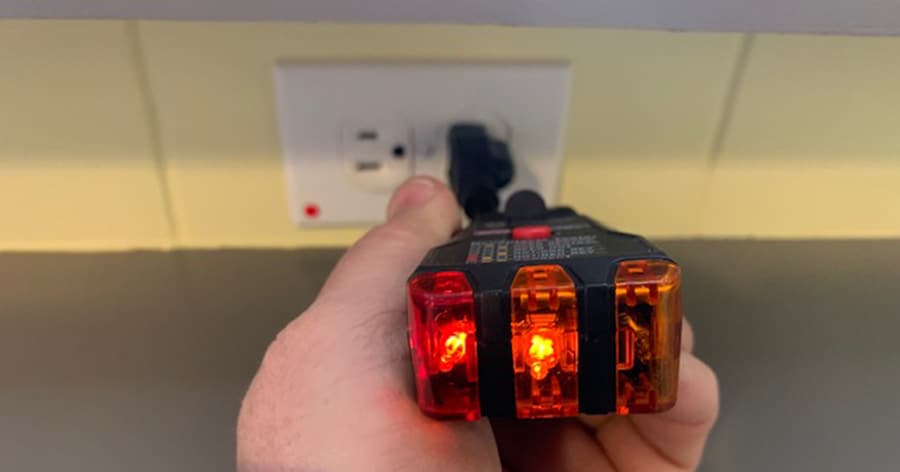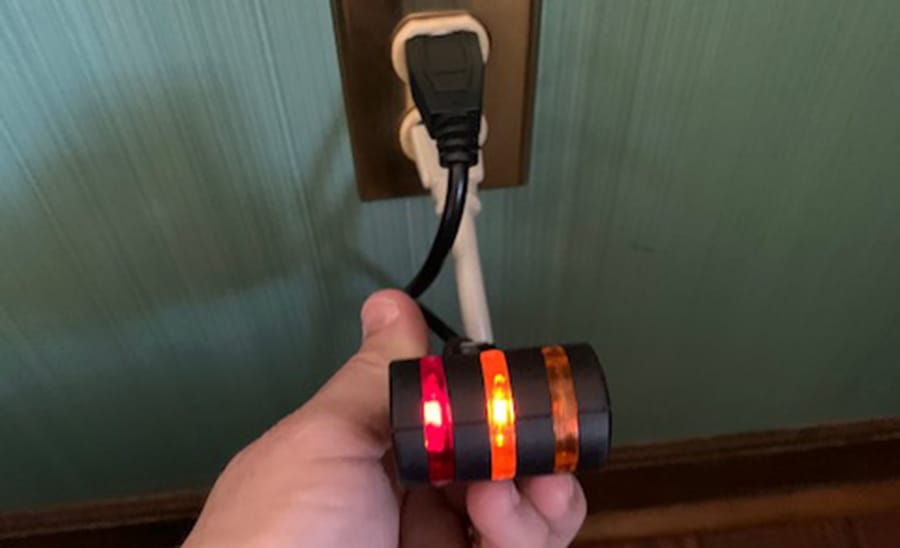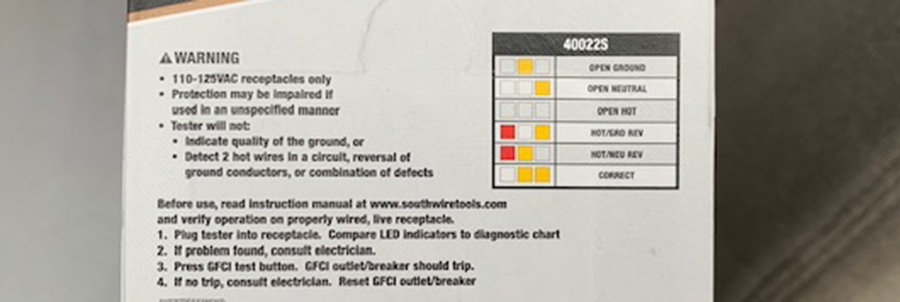
There’s nothing worse than a new phone, computer, or household appliance failing and not knowing why. If you are damaging phone cords, radios, or other devices more frequently than you think they should, your problem may be reverse polarity in your electrical receptacle.
Electrical outlets with reverse polarity can be dangerous to you and your devices. A device plugged into a receptacle with reversed polarity can remain energized even when turned off, which can short-circuit the device. Devices plugged into an outlet with reversed polarity may appear to work as usual but are unsafe and can shock you.
The electrical wiring in our homes is color-coded. The black wire or red wire will be the hot wire that carries an electric current to power your devices. The white wire is the neutral wire and has zero volts but is essential to the flow of electricity.
Outlets have a hot side and a neutral side. Reverse polarity happens when the installer connects the hot wire on the neutral side and the neutral wire on the hot side. In other words, reverse polarity occurs when a receptacle’s wiring is backward.
This article will explain the hazards of reversed polarity and provide information on testing and fixing the problem.
What Happens if Polarity is Reversed?
Before we carry on and explain what happens due to reversed polarity, let us explain how electricity typically flows. The electric current flow occurs throughout the receptacle onto the equipment or the plug. Usually, the current flow travels through the hot wire.
When the electricity reaches the equipment or tool, it flows to the on-off switch. The switch or circuit breaker controls the power supply of electric current flowing to appliances and other electronic equipment. It flows to the receptacle through the hot wire and then back to the panel through the neutral wire. So, what happens with reversed polarity?
In reversed polarity, both the hot wire and neutral wire get switched, causing the electric current to flow backward, entering the appliance through the neutral terminal instead of the hot terminal, which energizes the appliance even when off.
For example, plugging in a lamp into a reversed polarity outlet causes the light socket to become energized at all times, which can cause a shock hazard when touching the lamp socket to change the light bulb.
The same shock hazard can occur when you touch a small appliance with reverse polarity.
An example of how reversed polarity can be dangerous is when you plug a kitchen appliance, such as a blender, into an electric receptacle with reverse polarity. It would cause the blender to short out because the appliance can remain on when it’s supposed to be off.
The blender can only be off if it is unplugged from the outlet. Initially, plugging or unplugging the blender can be a shock hazard. It’s essential to ensure your outlets’ polarity is correct to avoid shock hazards from taking place.

Can Reverse Polarity Damage Appliances?
Although some modern-day devices have protective mechanisms that protect against reversed polarity, there is still a risk of losing their efficiency and or being damaged. Reversed polarity can damage or short-circuit your appliances. This wiring mistake within outlets can cause household appliances to overheat or damage the internal circuitry and wiring.
Plugging appliances into reversed polarity outlets is in danger of overheating or shorting out, which can shorten their lifespan. They may also malfunction, such as turning on suddenly without being activated, which can further damage your trusty appliance’s internal circuit.
Can Reverse Polarity Damage Electronics?
When plugged into an outlet wired incorrectly, reverse polarity can easily damage your electronics. If your electronics do not have any mechanism to protect against reverse polarity built into the circuitry, it is only a matter of time before they are damaged.
Reversed polarity can damage or short-circuit your electronics, including TVs, radios, phones, and computers. Electronic equipment controls voltage in one direction; thus, the internal components can overheat or short-circuit when you reverse the electrical flow.
Can Reverse Polarity Cause a Fire?
When house fires occur, the investigating Fire Marshall may point out a faulty appliance as the cause for the fire, and in most cases, they are accurate. However, they often overlook why the appliance failed. It’s just called electrical fire.
When you plug an appliance or electronic equipment into reverse polarity receptacles, the electrical current flowing through the device is backward, causing them to overheat or short-circuit. When an appliance or electronic equipment short-circuits, it can ignite nearby flammable materials like curtains, bedding, or furniture.
Appliances and electronics receive electricity through the electrical plug designed to carry electricity one-way through the appliance.
When you plug appliances into the reverse polarity circuit, the flow of electricity flows through the appliance in reverse. Essentially it’s like driving the wrong way down a one-way street.
This backward flow of electricity prevents appliances from turning off as it should. The appliance remains energized, which can overheat and potentially short-circuit the appliance.

How To Test For Reverse Polarity?
No one pays attention to the electrical outlets in our home unless a problem occurs. There is a chance that some of these outlets are wired incorrectly, and you wouldn’t know it.
Anyone can test electrical outlets for reverse polarity. Although there are different ways to test this, one of the easiest methods is using a standard outlet tester with a voltage chart.
- To test for reverse polarity, you will have to plug in the outlet tester into the receptacle you wish to check.
- Once plugged in, you will need to pay close attention to the lights displayed on the tester. By observing the lights on the tester, you will be able to determine whether or not the polarity in your outlet is correct.
- To understand the light pattern that will light up if the polarity is reversed, you will need to check the chart provided by the tester. There are slight differences in different kinds of polarity testers.
How To Fix Reverse Polarity?
The best way to fix incorrect polarity is the call an electrician. While the steps to correcting polarity may seem simple, the problem may be more complicated.
It’s common for an electrical circuit to have several junctions along the electric panel box’s path to the outlet. An electrician knows how to address these electrical issues. Working with live electricity is dangerous.
After testing the outlets in your home and finding that they have reversed polarity at some receptacles, you might be concerned about what to do next. Well, fear not; you can quickly fix reversed polarity in the outlets within your home. It is essential that before you begin to fix the problem, you identify how many of the outlets carry reversed polarity. Hence, you know how many standard outlets you need to repair.
Steps to Fix Outlet Reverse Polarity
- Shut off the power supply to the outlets by finding the corresponding circuit breaker and switching it off. Verify the power supply is off with the outlet tester or a multimeter.
- Remove the cover plate and the screws that join the outlet to the wall box and pull the outlet out of the wall box.
- Identify the wires that cause the reverse polarity, and to do this, you will need to check the color of the wires and the screws they are attached to.
- If the polarity is reversed, the black wire (hot wire) will be connected to the silver screw on the neutral terminal.
- Likewise, the white wire (neutral wire) will be attached to the brass screw on the hot terminal.
- If the wires are attached to the wrong terminals, you will need to change the wire connections to the correct terminals.
- To fix reverse polarity, attach the black wire (hot wire) to the brass screw on the hot side and attach the white wire (neutral wire) to the silver screw or the neutral side. The green wire will already be attached to the ground screw and should be left as it is.
- Once you have correctly attached the wires, replace the screws and the cover plate, and secure the outlet back onto the wall box.
- To confirm that the polarity is correct, switch the circuit breaker back on and check the polarity using the outlet tester. Use the guide on the outlet tester to confirm the correct polarity.
Frequently Asked Questions
What Causes Reverse Polarity?
There are a few different things that can cause reverse polarity in your electrical system. One of the most common causes is that the hot and neutral wiring at an outlet is incorrect. The reverse polarity of the wiring at a receptacle outlet is easy to correct.
Another problem that can cause a reverse polarity is the hot and neutral wiring inside a junction box is incorrect, which can be more difficult to troubleshoot.
Why is Reverse Polarity Bad?
The number one reason why reverse polarity is bad is that when appliances are plugged in they stay energized even when turned off. This can cause you to get an electrical shock from the appliance even if turned off. It can also cause appliances to wear out faster than usual because they are constantly energized.
Conclusion
The correct polarity within your house’s electrical system is essential as this can significantly impact all the electronics you own. Thus, it is necessary to know precisely what reverse polarity is and how to identify and fix this common problem. Luckily, you can fix reverse polarity usually without having to rewire circuits in your home.
Other Wiring Related Content







